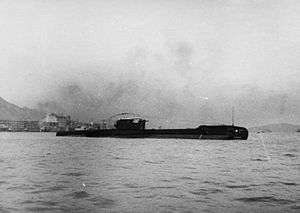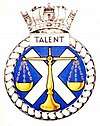HMS Talent (P337)
 HMS Talent | |
| History | |
|---|---|
| Name: | HMS Talent |
| Builder: | Vickers Armstrong, Barrow |
| Laid down: | 21 March 1944 |
| Launched: | 13 February 1945 |
| Commissioned: | 27 July 1945 |
| Fate: | Scrapped February 1970 |
| Badge: |
 |
| General characteristics | |
| Class and type: | British T class submarine |
| Displacement: |
|
| Length: | 276 ft 6 in (84.28 m) |
| Beam: | 25 ft 6 in (7.77 m) |
| Draught: |
|
| Propulsion: |
|
| Speed: |
|
| Range: | 4,500 nautical miles at 11 knots (8,330 km at 20 km/h) surfaced |
| Test depth: | 300 ft (91 m) max |
| Complement: | 61 |
| Armament: |
|
HMS Talent was a British submarine of the third group of the T class. She was built as P337(S37) by Vickers Armstrong, Barrow, and launched on 13 February 1945. She was originally to have been named HMS Tasman, but was this was changed to Talent after the previous HMS Talent was transferred to the Royal Netherlands Navy.
Service
Talent saw little action, but still had an eventful career. Her first commission was spent in the Far East after which she returned to the UK. She then spent her commissions alternating between the home and mediterranean stations. In 1953 she took part in the Fleet Review to celebrate the Coronation of Queen Elizabeth II.[1]
On 15 December 1954 she was swept out of drydock at Chatham Dockyard when the dock gate (caissoon) lifted. Thick fog, night-fall and high tides hampered the search and rescue operations. She was not found until next day when it became clear that the accident had claimed four lives. After this accident all caissoons at Chatham that were on the river (tidal ) were chained down to prevent them lifting and they were inspected more regularly to ensure that they were full of water.
She was reconstructed between 1954 and 1956, when she was streamlined and modified, including the removal of her 4-inch gun. She was then damaged in a collision while dived off the Isle of Wight on 8 May 1956. Talent was later used for a month-long publicity trip around the south and east coasts of England in October 1960, when she was visited by over 33,000 people.
She was refitted at Malta between late 1960 and early 1961, and was thereafter active in the Mediterranean. She returned to the UK in May 1962 and was present at Portsmouth Navy Days in 1965.[2] She was decommissioned on 19 December 1966[3] and was finally scrapped at Troon, Scotland on 1 February 1970.[4]
Commanding officers
| From | To | Captain |
|---|---|---|
| 1953 | 1953 | Lieutenant Commander P S Beale RN |
| 1960 | 1960 | Lieutenant Commander A N Derrick RN |
| 1961 | 1961 | Lieutenant Commander FRY RN |
| 1965 | 1965 | Lieutenant Commander N G Warnford RN |
References
- ↑ Souvenir Programme, Coronation Review of the Fleet, Spithead, 15th June 1953, HMSO, Gale and Polden
- ↑ Programme, Portsmouth Navy Days, 28–30 August 1965, HMSO, p15
- ↑ "Talent makes her last dive". Navy News. January 1967. p. 6. Retrieved 27 September 2018.
- ↑ HMS Talent, Uboat.net
Publications
- Colledge, J. J.; Warlow, Ben (2006) [1969]. Ships of the Royal Navy: The Complete Record of all Fighting Ships of the Royal Navy (Rev. ed.). London: Chatham Publishing. ISBN 978-1-86176-281-8. OCLC 67375475.
- Hutchinson, Robert (2001). Jane's Submarines: War Beneath the Waves from 1776 to the Present Day. London: HarperCollins. ISBN 978-0-00-710558-8. OCLC 53783010.